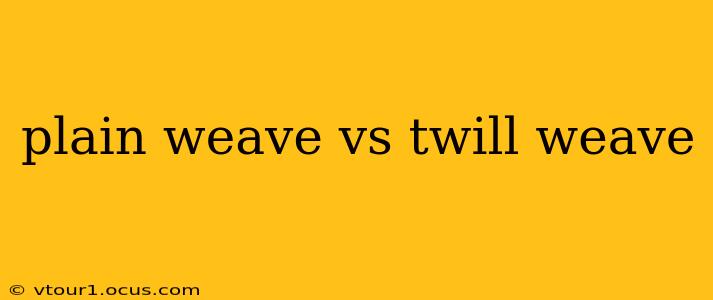Choosing the right fabric often depends on understanding its weave structure. Two of the most common weave types are plain weave and twill weave. While both create durable textiles, they differ significantly in appearance, texture, and properties. This article will delve into the key distinctions between plain weave and twill weave, helping you understand which is best suited for various applications.
What is Plain Weave?
Plain weave is the simplest and most fundamental weaving technique. It's characterized by a straightforward over-under pattern where the warp (lengthwise) yarns pass over and under the weft (crosswise) yarns in a regular, alternating sequence. This creates a balanced, even fabric with a distinct, uniform appearance.
Characteristics of Plain Weave:
- Simple structure: Easy to manufacture, making it a cost-effective option.
- Balanced texture: The even interlacing of warp and weft yarns results in a consistent surface.
- Moderate durability: Generally durable but can be prone to wrinkling and snagging depending on the fiber used.
- Breathability: Often breathable, making it suitable for clothing in warmer climates.
- Drape: Can have a crisp or soft drape depending on the fiber and yarn count.
What is Twill Weave?
Twill weave is more complex than plain weave, featuring a diagonal pattern created by passing the warp yarns over two or more weft yarns before going under one. This creates a characteristic diagonal line or rib on the fabric's surface. The angle of the twill line can vary, influencing the fabric's final appearance and properties.
Characteristics of Twill Weave:
- Diagonal pattern: Distinctive diagonal lines are the hallmark of twill weave.
- Stronger and more durable: The interlocking nature of the weave creates a stronger fabric less prone to snagging than plain weave.
- Better drape: Often has a smoother, more luxurious drape than plain weave.
- Increased warmth: The denser weave can provide better insulation than plain weave.
- Less breathable: Can be less breathable than plain weave due to the denser structure.
Plain Weave vs. Twill Weave: A Comparison Table
| Feature | Plain Weave | Twill Weave |
|---|---|---|
| Structure | Simple, over-under pattern | Diagonal pattern, warp yarns over multiple weft yarns |
| Appearance | Uniform, even surface | Diagonal lines or ribs |
| Durability | Moderate | High |
| Drape | Crisp or soft depending on fiber | Smooth, luxurious |
| Breathability | Good | Lower |
| Warmth | Moderate | Higher |
| Cost | Generally less expensive | Generally more expensive |
What are the common uses of plain weave and twill weave?
Common Uses of Plain Weave:
Plain weave fabrics are versatile and find use in a wide range of applications, including:
- Cotton T-shirts: The breathability and affordability make it ideal for everyday wear.
- Bed sheets: Simple, comfortable, and easy to care for.
- Tablecloths: The even surface and relative ease of cleaning are advantageous.
- Cotton canvas: Durable enough for bags, aprons, and other utilitarian items.
Common Uses of Twill Weave:
Twill weave's durability and drape make it suitable for:
- Denim: The iconic diagonal lines and strong structure of denim are hallmarks of twill weave.
- Tweed: The textured appearance and warmth make it suitable for outerwear.
- Gabardine: A tightly woven twill, often used in raincoats and suits for its water resistance.
- Flannel: A soft, brushed twill known for its warmth and comfort.
Which weave is right for me?
The best weave depends entirely on the intended use. If you need a breathable, cost-effective fabric, plain weave is a great choice. For increased durability, warmth, and a luxurious drape, twill weave is often preferred. Consider the characteristics of each weave and weigh them against your needs when selecting the appropriate fabric.
How can I identify plain weave vs. twill weave?
Identifying the weave type is straightforward: look for the diagonal lines! If there's a prominent diagonal pattern, it’s likely a twill weave. If the fabric has a consistent, even structure without prominent diagonals, it's probably plain weave.
What are the different types of twill weaves?
There are various types of twill weaves, each distinguished by the direction and steepness of the diagonal lines. These variations influence the final fabric's properties and aesthetics. Examples include left-hand twill, right-hand twill, and broken twill. Each type offers unique characteristics in terms of drape, strength, and visual appeal.
Is twill weave waterproof?
While some twill weaves can be water-resistant due to the tight weave and the use of certain fibers (like waxed cotton), it's not inherently waterproof. Waterproofing is often achieved through additional treatments applied to the fabric.
